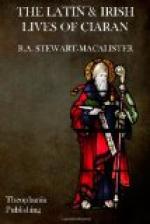It is quite clear that this curious story has reached us in a fragmentary and expurgated form, and that if we had the whole narrative before us it would afford us an indication that Clonmacnois was the site of an earlier, Pagan, sanctuary. It will most probably be found to be an invariable rule that the early Christian establishments in Ireland occupy the sites of Pagan sanctuaries; the monastery having been founded to re-consecrate the holy place to the True Faith. The hollow elm was doubtless a sacred tree; the well which miraculously burst forth was a sacred well: the buried leper may have been a foundation sacrifice, like Oran on Iona. The old pre-Christian name of the site is suggestive—Ard Tiprat, “the high place of the [holy] well.” By no stretch of language can the site of Clonmacnois be called physically high; as in the stanza quoted in VG 30, the word Ard must be used in the sense of distinguished, eminent, or sacred.
Of the prophecy attributed to Brigit there appears to be no record in any of her numerous Lives: nor can I identify with certainty the story of “the fire and the angel.” There were “Crosses of Brigit” at Armagh;[3] but as there were probably many other crosses throughout the country dedicated to this popular saint we cannot infer that Armagh was the scene of the prophecy.




